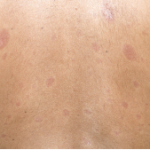Nephrogenic systemic fibrosis (NSF), first identified in 1997, is a rare but potentially lethal condition to consider and is related to exposure to gadolinium-based contrast agents in patients with renal failure. A patient with NSF may present with hyperpigmentation and a “woody” induration with significant skin involvement on the forearms and legs, he said. On a skin histopathology section, Dr. Silver pointed out noticeable differences in collagen bundles, including clefts between them that distinguish NSF from SSc. NSF’s prognosis is poor—the fibrosis and calcinosis can affect the heart, lung, diaphragm, and other organs, and it can lead to death, he said. If magnetic resonance imaging is needed for renal disease patients, “gadolinium-based contrast agents should be given at the lowest possible dose.”
Updated Criteria
The 1980 SSc classification criteria were recently updated by the ACR and the European League Against Rheumatism and published last November.1 Achieving a score of nine or higher is required for a definitive diagnosis of SSc. Definitive diagnosis may be made if there is skin thickening to the fingers of both hands extending proximal to the metacarpophalangeal joints. However, a combination of other symptoms can also achieve a score of nine without that, including telangiectasia, Raynaud’s phenomenon, positive tests for particular autoantibodies, and abnormal nailfold capillaries.
“We classify patients based on their skin involvement, on the basis of certain vascular features, as well as certain autoantibodies,” Dr. Silver said. If the patient has Raynaud’s phenomenon, susceptibility to cold may be more important than having tricolor involvement to indicate possible SSc, he added. “If you require one color, you are overdiagnosing, but if you require all three, you’re underdiagnosing Raynaud’s phenomenon,” he said. Nailfold capillary examination is a very useful method of distinguishing patients who have primary Raynaud’s phenomenon from those patients who have or are at risk of developing SSc, Dr. Silver said.
Autoantibodies that may indicate SSc are anti-Topo1, anti-RNA Poly III, and anticentromere, and are associated with particular subsets of disease and risks for complications, he added. Complications of SSc may include organ involvement, and rheumatologists should be aware of this possibility even early in the disease process, Dr. Silver said. “I feel that heart disease is an underrecognized complication of patients with diffuse cutaneous disease,” he added.
Dangerous Complications
Digital ulcers appear frequently and early in SSc patients, Dr. Silver noted. These ulcers are extremely painful and difficult to treat and heal, requiring aggressive therapy with vasodilators, although these are not always available in the United States, he said.
